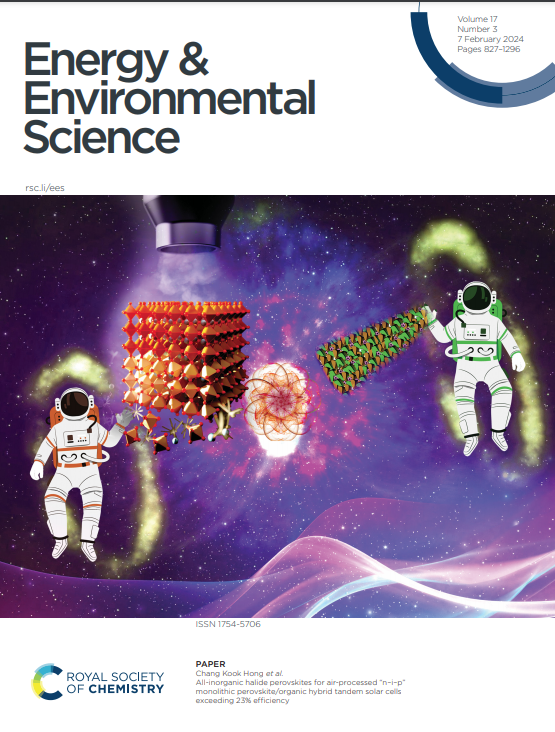阴离子-π 相互作用和溶剂脱氢控制使高压锂离子电池成为可能
IF 32.4
1区 材料科学
Q1 CHEMISTRY, MULTIDISCIPLINARY
引用次数: 0
摘要
延长锂钴氧化物(LCO)阴极的充电截止电压是提高锂离子电池(LIB)能量密度的有效策略,但形成不良阴极电解质相(CEI)限制了其广泛应用。各种电解质添加剂,尤其是腈化合物,在解决这些界面问题方面已显示出前景,但其基本设计原理仍不清楚。在此,我们介绍一种界面杠杆机制,利用吸附在 LCO 表面的腈类化合物来微调 CEI 成分。腈类添加剂对高压 LCO 的适用性取决于与溶剂(Esol)的排斥作用和与阴离子(Eanion)的吸引作用。前者抑制溶剂的分解,而后者则促进阴离子在 CEI 构建过程中的分解。正如在商用碳酸盐电解液中使用 3,5-双(三氟甲基)苯甲腈(BFBN)所证明的那样,这些相互作用可以通过腈化合物的功能设计进行定制。BFBN 分子通过氰基(-CN)和钴(Co)原子之间的配位吸附到 LCO 表面。BFBN 与溶剂发生排斥作用,并通过阴离子-π 相互作用与阴离子发生吸引作用,从而抑制碳酸盐溶剂的脱氢,同时促进 PF6-阴离子的分解,形成富含无机物的 CEI。添加 1 wt.% 的 BFBN 可使 4.55 V 石墨||LCO 袋式电池在 25 °C 下循环 550 次以上,在 45 °C 下循环 145 次以上,大大超过了在基线电解液中观察到的大约 110 次和 50 次循环的寿命。这项研究为高能量密度 LIB 的高压电解质添加剂设计提供了新的见解。本文章由计算机程序翻译,如有差异,请以英文原文为准。
Anion-π Interaction and Solvent Dehydrogenation Control Enable High-Voltage Lithium-ion Batteries
Extending the charging cutoff voltage of lithium cobalt oxide (LCO) cathode is an effective strategy to enhance energy density of lithium-ion batteries (LIBs), while the formation of poor cathode electrolyte interphase (CEI) has limited its widespread application. Various electrolyte additives, particularly nitrile compounds, have shown promise in addressing these interfacial issues, though the fundamental design principles remain unclear. Herein, we introduce an interfacial leverage mechanism utilizing nitriles adsorbed on LCO surface to fine-tune the CEI composition. A nitrile additive's suitability for high-voltage LCO is determined by the repulsive interaction with the solvent (Esol) and the attractive interaction with the anion (Eanion). The former inhibits solvent decomposition, while the latter facilitates the anion decomposition during CEI construction. These interactions can be tailored through the functional design of nitrile compounds, as demonstrated using 3,5-bis(trifluoromethyl)benzonitrile (BFBN) in a commercial carbonate electrolyte. The BFBN molecules adsorb onto the LCO surface through coordination between cyano groups (-CN) and cobalt (Co) atoms. Exhibiting repulsive interactions with the solvent and attractive interactions with the anion through anion-π interaction, BFBN suppresses carbonate solvent dehydrogenation while promoting PF6- anions decomposition to form an inorganic-rich CEI. A 1 wt.% addition of BFBN enables 4.55 V-graphite||LCO pouch cells to achieve over 550 cycles at 25 °C and more than 145 cycles at 45 °C, significantly surpassing the lifespan of around 110 and 50 cycles observed in the baseline electrolyte. This work provides new insights into the design of high-voltage electrolyte additives for high-energy-density LIBs.
求助全文
通过发布文献求助,成功后即可免费获取论文全文。
去求助
来源期刊

Energy & Environmental Science
化学-工程:化工
CiteScore
50.50
自引率
2.20%
发文量
349
审稿时长
2.2 months
期刊介绍:
Energy & Environmental Science, a peer-reviewed scientific journal, publishes original research and review articles covering interdisciplinary topics in the (bio)chemical and (bio)physical sciences, as well as chemical engineering disciplines. Published monthly by the Royal Society of Chemistry (RSC), a not-for-profit publisher, Energy & Environmental Science is recognized as a leading journal. It boasts an impressive impact factor of 8.500 as of 2009, ranking 8th among 140 journals in the category "Chemistry, Multidisciplinary," second among 71 journals in "Energy & Fuels," second among 128 journals in "Engineering, Chemical," and first among 181 scientific journals in "Environmental Sciences."
Energy & Environmental Science publishes various types of articles, including Research Papers (original scientific work), Review Articles, Perspectives, and Minireviews (feature review-type articles of broad interest), Communications (original scientific work of an urgent nature), Opinions (personal, often speculative viewpoints or hypotheses on current topics), and Analysis Articles (in-depth examination of energy-related issues).
 求助内容:
求助内容: 应助结果提醒方式:
应助结果提醒方式:


